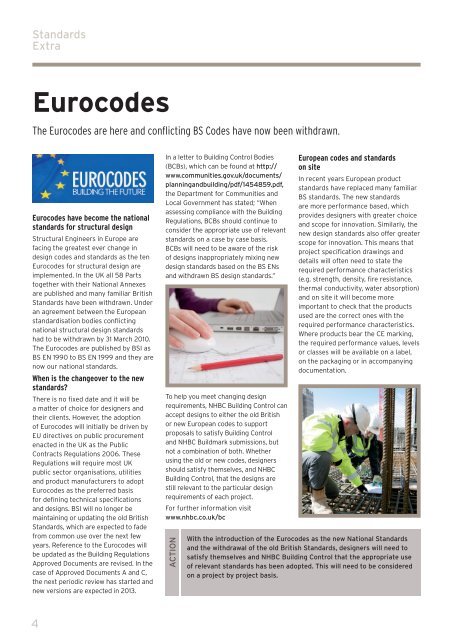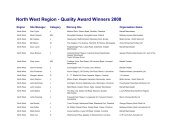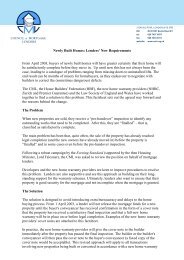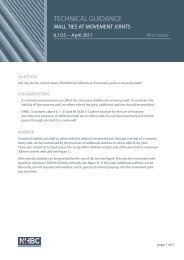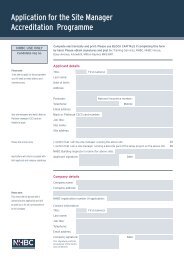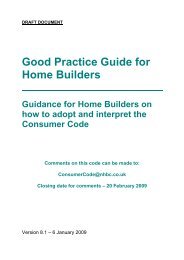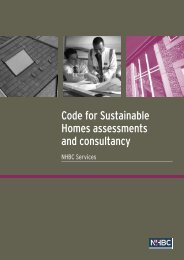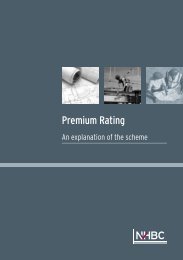June 2010 - NHBC Home
June 2010 - NHBC Home
June 2010 - NHBC Home
Create successful ePaper yourself
Turn your PDF publications into a flip-book with our unique Google optimized e-Paper software.
Standards<br />
Extra<br />
Eurocodes<br />
The Eurocodes are here and conflicting BS Codes have now been withdrawn.<br />
Eurocodes have become the national<br />
standards for structural design<br />
Structural Engineers in Europe are<br />
facing the greatest ever change in<br />
design codes and standards as the ten<br />
Eurocodes for structural design are<br />
implemented. In the UK all 58 Parts<br />
together with their National Annexes<br />
are published and many familiar British<br />
Standards have been withdrawn. Under<br />
an agreement between the European<br />
standardisation bodies conflicting<br />
national structural design standards<br />
had to be withdrawn by 31 March <strong>2010</strong>.<br />
The Eurocodes are published by BSI as<br />
BS EN 1990 to BS EN 1999 and they are<br />
now our national standards.<br />
When is the changeover to the new<br />
standards?<br />
There is no fixed date and it will be<br />
a matter of choice for designers and<br />
their clients. However, the adoption<br />
of Eurocodes will initially be driven by<br />
EU directives on public procurement<br />
enacted in the UK as the Public<br />
Contracts Regulations 2006. These<br />
Regulations will require most UK<br />
public sector organisations, utilities<br />
and product manufacturers to adopt<br />
Eurocodes as the preferred basis<br />
for defining technical specifications<br />
and designs. BSI will no longer be<br />
maintaining or updating the old British<br />
Standards, which are expected to fade<br />
from common use over the next few<br />
years. Reference to the Eurocodes will<br />
be updated as the Building Regulations<br />
Approved Documents are revised. In the<br />
case of Approved Documents A and C,<br />
the next periodic review has started and<br />
new versions are expected in 2013.<br />
In a letter to Building Control Bodies<br />
(BCBs), which can be found at http://<br />
www.communities.gov.uk/documents/<br />
planningandbuilding/pdf/1454859.pdf,<br />
the Department for Communities and<br />
Local Government has stated; “When<br />
assessing compliance with the Building<br />
Regulations, BCBs should continue to<br />
consider the appropriate use of relevant<br />
standards on a case by case basis.<br />
BCBs will need to be aware of the risk<br />
of designs inappropriately mixing new<br />
design standards based on the BS ENs<br />
and withdrawn BS design standards.”<br />
To help you meet changing design<br />
requirements, <strong>NHBC</strong> Building Control can<br />
accept designs to either the old British<br />
or new European codes to support<br />
proposals to satisfy Building Control<br />
and <strong>NHBC</strong> Buildmark submissions, but<br />
not a combination of both. Whether<br />
using the old or new codes, designers<br />
should satisfy themselves, and <strong>NHBC</strong><br />
Building Control, that the designs are<br />
still relevant to the particular design<br />
requirements of each project.<br />
For further information visit<br />
www.nhbc.co.uk/bc<br />
ACTION<br />
European codes and standards<br />
on site<br />
In recent years European product<br />
standards have replaced many familiar<br />
BS standards. The new standards<br />
are more performance based, which<br />
provides designers with greater choice<br />
and scope for innovation. Similarly, the<br />
new design standards also offer greater<br />
scope for innovation. This means that<br />
project specification drawings and<br />
details will often need to state the<br />
required performance characteristics<br />
(e.g. strength, density, fire resistance,<br />
thermal conductivity, water absorption)<br />
and on site it will become more<br />
important to check that the products<br />
used are the correct ones with the<br />
required performance characteristics.<br />
Where products bear the CE marking,<br />
the required performance values, levels<br />
or classes will be available on a label,<br />
on the packaging or in accompanying<br />
documentation.<br />
With the introduction of the Eurocodes as the new National Standards<br />
and the withdrawal of the old British Standards, designers will need to<br />
satisfy themselves and <strong>NHBC</strong> Building Control that the appropriate use<br />
of relevant standards has been adopted. This will need to be considered<br />
on a project by project basis.<br />
4


